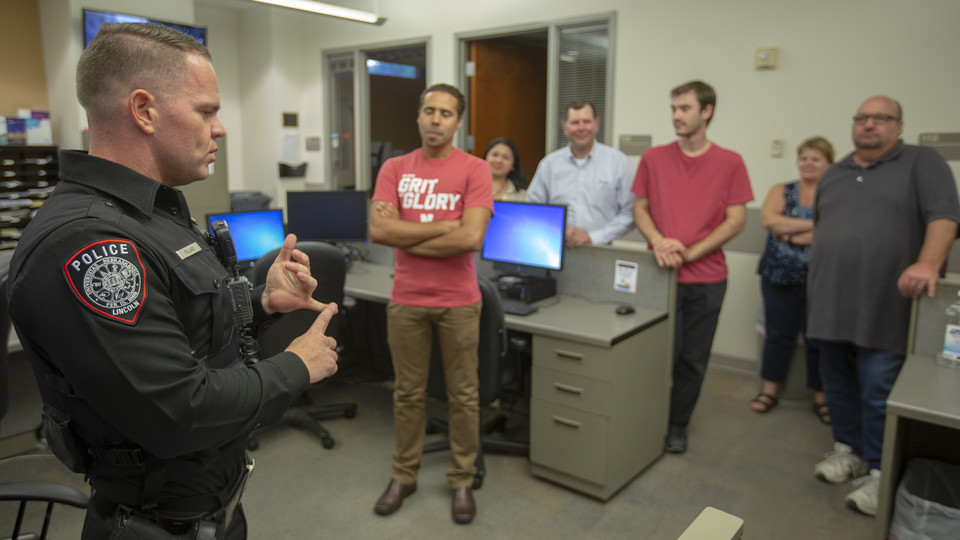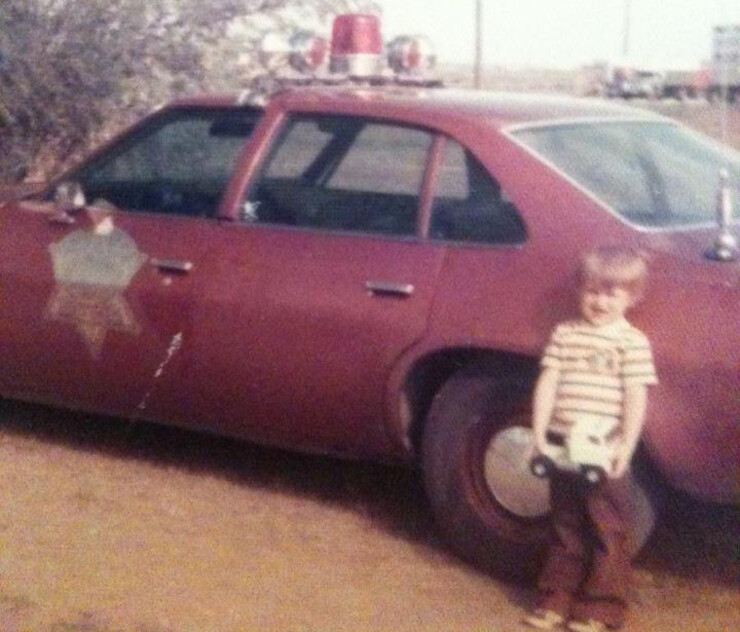· 5 min read
12 earn opportunity to step behind the thin blue line

Earlier this week, a dozen University of Nebraska–Lincoln volunteers took first steps in learning about the University Police Department.
I’m one of the 12 students, faculty and staff taking part in the university’s inaugural Citizens’ Police Academy, a six-week program designed to educate members of the campus community about the University Police Department. We’ll learn about campus public safety resources and police procedures.
We’ll also get the chance to see K-9 units in action, learn how to safely apply handcuffs, spend time in dispatch and ride along with a UPD officer. It’s remotely possible this will afford me my third high-speed police chase.
The first was when I was 5, sitting in my dad’s patrol car as he filled the gas tank. Then a deputy in Brown County, South Dakota, dad was in the middle of a shift and our family met up at McDonald’s for a rare supper together.
I devoured the much-too-large Big Mac and was able to take a short ride to the gas station as mom followed. Her arrival was slightly delayed and, as dad topped off the tank, a car drove by in a blur, well above the posted speed limit.
Dad jumped in his brown cruiser, switched on the cherry light and siren, and told me to buckle up. The chase — of which I remember only snippets — was on.
The experience became a recurring dream, a fluid thing filled with red lights, gravel-road dust, an apprehension with handcuffs, the man’s hard eyes reflected in the rear-view mirror and me regurgitating a Big Mac. The last time I had that dream was in college. It inspired a long-lost watercolor painting in an art course led by Susan Puelz. After creating that painting, I never had the dream again. To this day, I can’t eat a Big Mac — no big loss.
My second high speed chase was on the other side of the law as a back-seat passenger in a car that took to rural South Dakota roads to avoid pursuit. I remember it started with a series of high speed donuts in the middle of the Highway 46 near the five-mile corner. If you need more details, let me know.
In the first academy session, led by Officer Ryan Pillard, we learned the basics about the University Police Department, toured the UPD station and spent an amazingly candid 30-plus minutes question-and-answer session with UPD leadership, including Chief Owen Yardley and Assistant Chief Hassan Ramzah.
Next week, we’ll get the opportunity to shoot paint pellet guns in a scenario within the old University Health Center, interact with the K-9 teams, use handcuffs and learn more about police procedures.
Throughout the next five weeks, I plan to report on what we learn each Friday, helping expand the reach of the UPD’s first citizens’ police academy and — possibly — stoke your desire to become a member of an upcoming cadre.
Along the way, we’ll talk to the faculty, staff and student who are part of the first class of academy “students.” They include Alex Andersen, Erin Bauer, Beth Cullinane, Regina Flowers, Greg Gray, Mandy Haase-Thomas, Meg Kester, Yassine Rfissa, Naomi Rodriguez, Julie Thomsen and Jeff Witkowski.
Here are a few facts we learned during the opening session on Sept. 19.
• UPD started as a campus security unit in 1926 with the hiring of a single officer. It became an official police department in 1969.
• There have been four police chiefs in the UPD's 49 years, with Yardley (18) and former chief Gail Gade (20) leading for 38 years.
• Today, the department includes 36 commissioned and another 40 non-commissioned officers; seven sergeants; an investigation unit with three officers and a sergeant; two K-9 teams; a two-member team that leads emergency management activities; 10 community service officers; a dispatch team of 12; an information technology team; and seven student workers.
• A daily campus crime and fire log is available online.
• The department has is accredited by the Commission on Accreditation for Law Enforcement Agencies, an international organization. Nationwide, only about 2.5 percent of campus law enforcement agencies and 4 percent of public safety agencies have gained accredited status through the commission. Only six police organizations in Nebraska currently have earned this honor.
• And, I made Sgt. Doug Petersen feel a bit old after saying I remember him from my college days — it didn't help when I pointed out that my oldest is a freshman English major. Sgt. Petersen has served 40 years with the department and will be among those honored during the Celebration of Service on Sept. 25. I recommend that you spend some time talking with him as he is a fountain of university history and — like all career police officers — has some really great stories to tell.
Ultimately, I hope this story series is informative and helps provide the campus community with insight into the thin blue line that is police enforcement.
As always, we welcome your opinions. If you like a story, please share it via a favorite social media channel. If you have questions, feedback, desire more information or would like to let us know about a great story here on campus, reach out directly to nebraskatoday@unl.edu or call 402-472-8515.
Troy Fedderson
Director of Internal Communication
Editor, Nebraska Today









